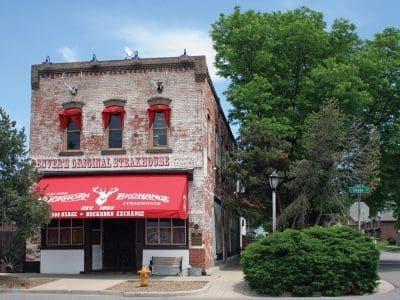By Brad and Shawna Geiger, Contributing Editors
If you’re eating mountain oysters underneath a stuffed water buffalo and signed pictures of two U.S. presidents, you’re probably in the Buckhorn Exchange, a century-old Denver institution and possessor of Colorado liquor license number one.
Stepping off a commuter light rail and walking across the street to the Buckhorn Exchange is merely 100 steps forward, but 124 years back in time the minute you open the door. The host and hostess are the first to welcome you, offering early access to your reserved table or directions to the Victorian Lounge just up the stairs. For a taste of the ambiance and the chance to have signature cocktails in a true Prohibition-style lounge, the upstairs bar was an obvious choice.
 With a white oak bar and back bar made in Germany in 1857 at the front and comfortable seating on couches and chairs toward the back, there’s something for everyone.
With a white oak bar and back bar made in Germany in 1857 at the front and comfortable seating on couches and chairs toward the back, there’s something for everyone.
From a St. Mary’s Glacier to a Mountain Breeze and Buffalo Bill Cocktail, all the drinks were strong and refreshing. As soon as the table was ready, the bartender came with the check to take downstairs to our waitress, Joanne. The promise of live music in the bar offered by a 70-something-year-old cowboy playing two harpsichords was tempting, but the table waited downstairs.
The classic checkered tablecloth perfectly fit the decor. The table was placed in front of a display case featuring 125 vintage weapons, from shotguns and cap and ball rifles to a rare palm pistol. Above us hung no fewer than a baker’s dozen of mounted antelope heads, and all around us there were animals of every sort, including an albino bison, a wolverine and a two-headed cow. There was plenty to explore while we waited for our meals.
The menu, printed as part of a vintage newspaper with articles about the history of Denver and the Buckhorn, includes New York strip and tenderloin steaks as well as bison, lamb and quail. Combinations are encouraged. Mountain oysters are always on the appetizer menu, along with fried artichoke hearts, buffalo sausage and other fare.
Specials for the night included fried alligator tail and steamed rattlesnake. While the Buckhorn Exchange is widely renowned for serving a variety of game and fish, the focus rightly remains on beef, with all the meats locally sourced within the Rocky Mountain region.
The sides are simple, as are the salads, and Joanne discourages ordering your meat overdone. For big eaters, the “big steak,” weighing up to four pounds, and their massive 24-oz. porterhouse are reasonable options.
Joanne’s quick wit and obvious knowledge of the restaurant’s history made her a delightful addition to the experience. Her encouragement for everyone to have plenty of drinks didn’t hurt. This clearly wasn’t her first rodeo.
To be sure, there is a lot of history for her to know. The Buckhorn Exchange opened in 1893 under the ownership of Henry H. “Shorty Scout” Zietz. After retiring from Buffalo Bill’s Wild West Show, Zietz opened the restaurant at its current location at 10th and Osage, catering to cattlemen, railroad builders and the occasional Indian chief. It has hosted five U.S. Presidents, and photos of dozens of celebrity diners and politicians adorn the walls. Joining those photos are the 575 pieces of taxidermy.
Nearly all manner of western wildlife is represented, along with the occasional monkey.
Although Zietz’s family was forced to sell in 1978, the new owners haven’t disturbed the original building, which was designated an historic landmark by the city and county of Denver in 1972.
Along with preserving the building, the new owners have clearly succeeded at preserving the ambiance and flavor intended by Shorty Scout. This unique dining experience is a reminder of Denver’s cow town past, nestled among the rapidly gentrifying residences and modern-fusion restaurants. Its easy access by rail and international reputation continue to make this Denver mainstay a dining destination for tourists and locals alike, so be sure to make a reservation.






